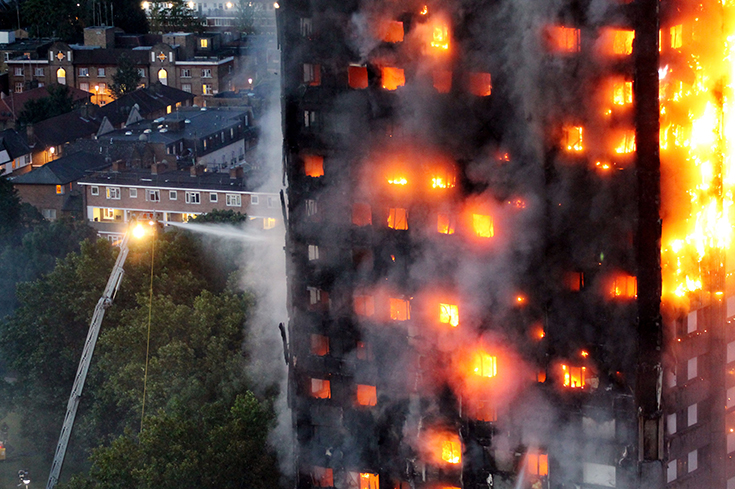Twenty-four storey tower alight in London - update
The 24-storey Grenfell Tower in Kensington, West London, caught fire and was engulfed by flames in the early hours of the morning of June 14. Six fatalities have been reported and 74 people have been taken to hospital, 20 of them with critical injuries.

The blaze, which broke out in the early hours, rapidly spread through the building (Rex/Shutterstock)
The fire broke out in the second floor and quickly spread through the entire building, engulfing it in flames and smoke that could be seen from miles around.
London Fire Brigade received multiple calls, with the first call received at 00:54hrs – fire crews arrived on scene in under six minutes.
Reports say that residents could be screaming and waving from their windows, and some newspapers are reporting that people jumped from windows to escape the flames, while others were seen escaping using bedsheets as improvised rope ladders.
London Fire Brigade Commissioner, Dany Cotton said in a statement: “This is an unprecendented situation,” and that a major incident was declared, based on the level of resources that were needed. More than 200 firefighters attended the incident, with 40 fire engines and other specialist vehicles, including 14 fire rescue units. “Crews wearing breathing apparatus have been working in extremely difficult conditions to rescue people,” she added.
London Ambulance Service Assistant Director of Operations, Stuart Crichton, said: “We have taken over 50 patients to five hospitals across London.
“Over 100 of our medics are working hard to respond to this incident, including ambulance crews, advanced paramedics, advanced trauma teams from London’s Air Ambulance and those staff managing the incident in our special operations centre. In addition, our hazardous area response teams are also on scene.”
Kensington and Chelsea Borough Council activated its major emergency plan and local authority liaison officers worked with the emergency services at the scene. An emergency rest centre has been opened for evacuees and volunteer organisations were in attendance to provide clothing and food.
Extensive cordons were put in place, nearby residents were evacuated and the A40 – a major trunk road – was closed in both directions.
The residential high-rise building was built in 1974 and contains 120 homes. It has recently been part of a £10 million refurbishment, including new windows, insulation and cladding, as well as a complete upgrade to the heating system. It emerged that a residents’ action group had made repeated warnings about the standard of fire safety, after a power surge in 2013 damaged electrical equipment – the Greenfell Action Group later said that it believed a fire disaster was narrowly averted in 2013: “When residents experienced a period of terrifying power surges that were subsequently found to have been caused by faulty wiring.”
The group also voiced concerns about access to the building for emergency services and lack of fire warnings posted for residents, as well as saying that residents had been told to seek shelter in their flats in the event of a fire. The Guardian newspaper published an exerpt from a newsletter to residents that said: “Our longstanding ‘stay put’ policy stays in force until you are told otherwise. This means that (unless there is a fire in your flat or in the hallway outside your flat) you should stay inside your flat. This is because Grenfell was designed according to rigorous fire safety standards. Also, the new front doors for each flat can withstand a fire for up to 30 minutes, which gives plenty of time for the fire brigade to arrive.
In a blog published in November 2016, the group said: “It is a truly terrifying thought but the Grenfell Action Group firmly believe that only a catastrophic event will expose the ineptitude and incompetence of our landlord."
As of 09:45hrs this morning, Commissioner Cotton confirmed that firefighters were making steady progress up the building, saying that they had reached the 21st floor.